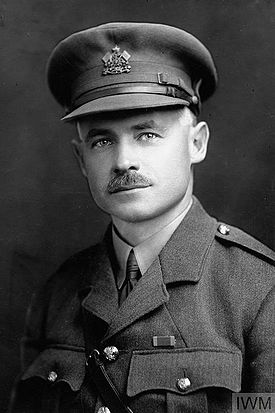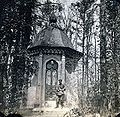Lister, Frederick Alexander
| Frederick Alexander Lister | |
|---|---|
| 17 September 1873 – 1960 | |
 | |
| Place of birth | Sarnia, Ontario |
| Place of burial | Lakeview Cemetery, Lambton County, Ontario |
| Allegiance | Canada |
| Service/branch | Canadian Army |
| Years of service | 1898 - 1932 |
| Rank | Brigadier |
| Awards | DSO, MiD |
Early Life
Frederick Alexander Lister was born 17 September 1873 in Sarnia Ontario, the son of the Honourable James Frederick Lister, Justice of the Supreme Court of Ontario and Eliza Ann Alexander. He had two older sisters as well as two younger sisters and a younger brother. He was educated in public school and collegiate institute in Sarnia before attending Upper Canada College in Toronto.[1]
Service
F.A. Lister was a Second Lieutenant in the 27th Lambton Battalion of Infantry, St. Clair Borderers in August 1897 and a Lieutenant in 1898 prior to transferring to the Royal Canadian Regiment as a Lieutenant in 1898. He was promoted Brevet Captain in 1901, the same year he commanded a guard of honour during the visit of the Prince and Princess of Wales (late King George V. and Queen Mary). He was appointed Adjutant at No. 2 Regimental Depot RCR in Toronto prior to taking up the same appointment at No. 4 Regimental Depot on 1 July 1901.
He was appointed to the General Staff as Assistant Inspector of Signalling (East) on 2 February 1904.[2] with responsibility of overseeing signal training in Eastern Canada, Militia Districts 5, 6, 7, 8, 9, and 12 from his headquarters in Fredericton and later Quebec City. In December 1904, Lister's appointment was amended to make him Assistant Inspector of Signalling effective back to February 2nd.[3] He completed a signalling course at the British School of Signalling, Aldershot England in 1903[4] or 1904[5]. On 1 December 1905 he was promoted substantive Captain.[6] In 1906 his position was re-titled Deputy Assistant Adjutant-General for Signalling (Deputy A.A.G.S) and he was re-appointed on March 20th 1906.[7]
In 1909 he returned to regimental duty with the RCR but returned to the Corps in 1910 after the death of Major Carruthers as the Assistant Adjutant-General for Signalling.[8] On 1 January 1911 the position was re-titled Assistant Director of Signals and moved from the Adjutant-General's Branch to that of the Chief of the General Staff's.[9]
In the Great War he was appointed to Command 1st Canadian Divisional Signal Company. The unit proceeded to England in September 1914 and then to France in February 1915. In December 1915 he was transferred to England to be in charge of the Signal Training Depot (part of the Canadian Engineer Training Depot)[10] where he was made a Brevet Lieutenant-Colonel. He later served as the Deputy Assistant Adjutant and Quartermaster-General of the Canadian Training Area in England in 1917 from 31 May 1917 until 17 October 1919. For his service during the war he was awarded the Distinguished Service Order (DSO)[11], was Mentioned in Despatches[12] and brought to the notice of the Secretary of State for War for valuable services rendered in connection with the war.[13]
After the war he was promoted Lieutenant-Colonel and served as the Garrison Adjutant of Halifax Fortress; Assistant Adjutant and-Quartermaster General at Regina, Saskatchewan and London, Ontario; and finally, Director of Organization and Personal Services at Ottawa, Ontario.
Colonel Lister retired on 26 November 1932 and was made an Honorary Brigadier.
Personal Life
In January 1905, Lister married Annie Hutton Watson (1871-1964). Together they had a son in 1907, James Frederick Alexander Lister (1907–1964), and a daughter in 1913, Marjorie Eileen Lister (1913–1989).
He died in 1960 and is buried in Lakeview Cemetery, Lambton County, Ontario.[14]
Departures from Signals Duties
Brigadier Lister was an officer of the Royal Canadian Regiment throughout his career although he was assigned signalling duties on two occasions. His first period of service ended in 1909 but he returned in 1910 after the death of Major Carruthers, the founder of the Canadian Signalling Corps. He immediately implemented a series of changes that suggested to some that his departure in 1909 may have had it's cause in some differences of opinion with Bruce Carruthers[4] however this does not appear to be the case. In accordance with policy at the time, appointments of staff officers was for a period of five years. Based on his appointment in 1904, Lister's term expired in February 1909 however he was extended until 30 April 1909 to avoid a winter move.[15]
His departure from command of the 1st Canadian Divisional Signal Company does appear to have been the result of personal differences. The opening line in the unit war diary for 24 October 1915 reads:"Visited Corps Headquarters re adoption of 'C.S.C'"the second and third lines of the same date read:
"In office all afternoon, an applicant for transfer.
Saw Maj-Gen Harrington re Training Depot."
Related Pages
Related Items
References
- ↑ Canadian Census - 1871, 1881, 1891, 1901
- ↑ Canada Gazette, Volume 37, Number 35, General Order 28. 27 February 1904, Page 1627.
- ↑ Canada Gazette, Volume 38, Number 29. General Order 177. 14 January, 1905. Page 1427.
- ↑ 4.0 4.1 History of the Royal Canadian Corps of Signals 1903-1961, John S. Moir (editor).
- ↑ The Canadian Who's Who 1936-1937
- ↑ General Order 38 of 1906
- ↑ General Order 39 of 1906
- ↑ Canada Gazette, Volume 44, Number 25. 17 December, 1910. Page 1888.
- ↑ General Order 176 of 1910
- ↑ War Diary - 1st Canadian Divisional Signal Company - 30 Nov & 6 Dec 1915.
- ↑ The London Gazette, Supplement 29202, 23 June, 1915. Page 6129.
- ↑ The London Gazette, Supplement 29200. 18 June, 1915. Page 6011.
- ↑ WO List 24-2-1917
- ↑ CanadaGenWeb's Cemetery Project
- ↑ F.A. Lister personnel file, Library and Archives Canada.
.







